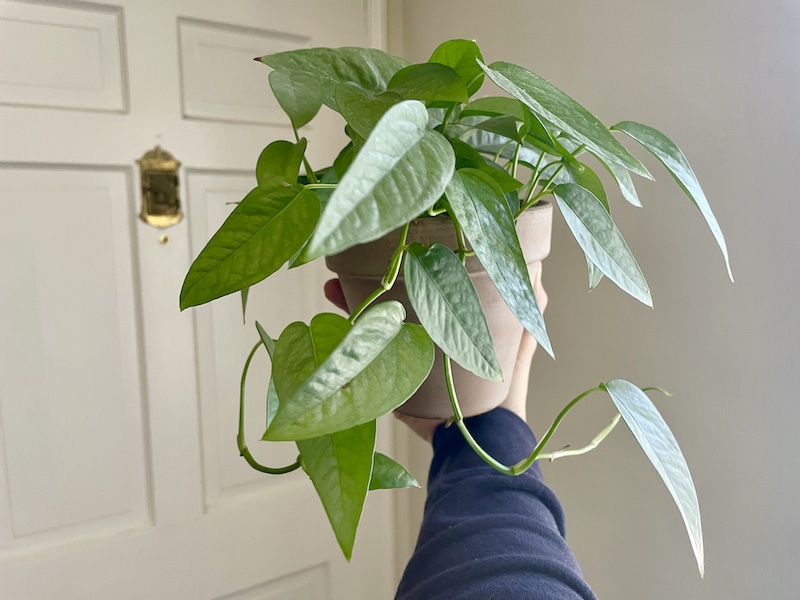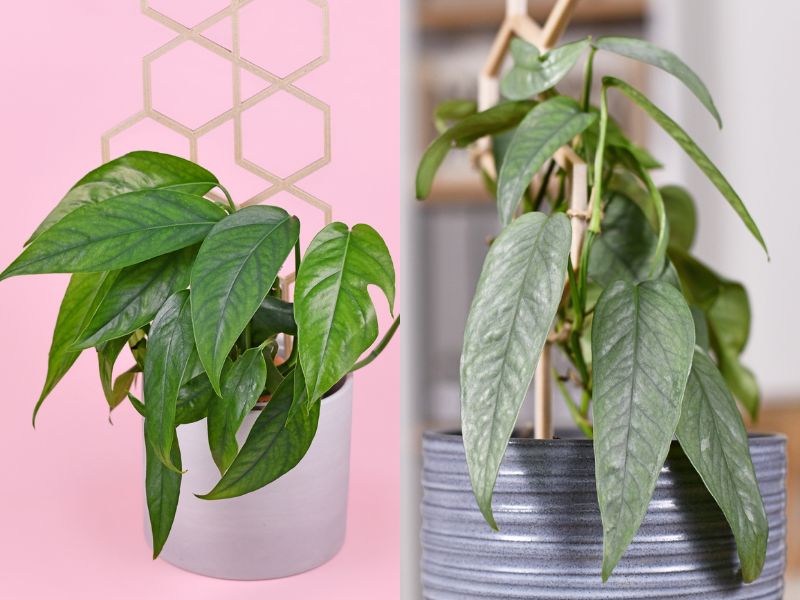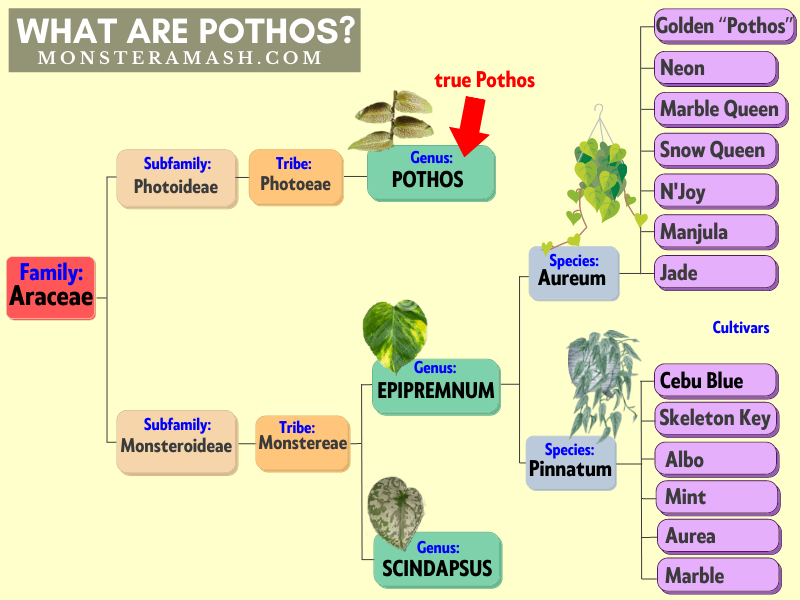The blue shiny leaves, the elegant shape, and the vining aesthetic of the Epipremnum Pinnatum Cebu Blue make it a beautiful addition to any plant lover’s collection.
Native to Cebu Island in the Philippines, the Cebu Blue Pothos is a low-maintenance tropical plant that thrives in a wide range of light conditions. You can watch it go through its distinct phases from having juvenile silvery elongated leaves to large, adult fenestrated leaves.
Although the Cebu Blue Pothos has been around for a long time, its popularity in the house plant community has shown a steady increase in recent years, peaking in 2021 according to Google Trends.
In this article, you’ll learn all about the history, origin, growth behavior, and ideal care tips for the Cebu Blue! Let’s get to it!
Table of Contents
My Experience With Cebu Blue Pothos

I [Allison, the editor] have found my Cebu Blue Pothos to be extremely easy-to-care-for and forgiving of neglect.
It’s tolerated all that I’ve thrown at it— low light, infrequent waterings, underfertilizing— and still remained an elegant and healthy-looking plant.
It hasn’t grown at a particularly fast rate (likely due to my neglectful plant parenthood) but I’m planning to repot it in LECA soon to see if that can accelerate its growth– like it has for my Monstera Peru and Siltepecana, both of which love LECA.
For those who don’t know, LECA is a growing medium made out of clay balls. It removes common problems in soil-based gardening such as spider mites, and fungus gnats laying eggs on the topsoil or crawling their way through the bottom of the pot.
Where Can I Find Cebu Blue Pothos for Sale?
There are many different ways you can grow a Pothos Cebu Blue: from seeds and nodes (wet sticks), to unrooted and rooted cuttings. Of course, the easiest way to acquire this easy-care plant is by purchasing it already established and potted from your local nursery.
As of writing, the Cebu Blue is somewhat a rare plant. It’s not readily available in regular plant stores within the US, Canada, Europe, and Northern Australia. Instead, you can look online for affordable prices.
Cebu Blue Pothos Cuttings
If you don’t have a lot of funds, cuttings are the way to go. Cebu Blue Pothos plants are such good growers! A few cuttings can easily turn into a lovely trailing plant in a short amount of time. Just remember to give it much water and much fertilizer.
I recommend this seller on Etsy who has some beautiful cuttings of Cebu Blue, selling two for under $10.
Cebu Blue Pothos Plants
For not much more, you can get a full-grown Cebu Blue Pothos in a 4-inch pot costing about $20. It’s a way better deal, especially if you’re not particularly patient with waiting for a small plant to grow.
This is a highly-reviewed seller on Etsy with some beautiful looking Cebu Blues for a great price!
Cebu Blue Pothos Overview & Origin
The Cebu Blue Pothos is valued by plant collectors for the intricate veining on its leaves, with a silvery blue sheen that is reminiscent of a blue Philodendron Silver Sword. This plant is also often compared to the Monstera Siltepecana for its embossed texture.
Like its name suggests, the Cebu Blue is native to the tropical island of Cebu in the Philippines. As someone who comes from this country, I can tell you that this gorgeous plant can be seen growing abundantly under big Acacia trees and along river banks!
The Cebu Blue is a cultivar of Epipremnum pinnatum, which is a species that has a long history of name changes and reclassifications in taxonomy. It sometimes goes by the common name “pothos”, but it’s not truly a pothos variety! Later, we’ll explain why.
The Cebu Blue dramatically changes from its juvenile phase with small, elongated leaves to its mature phase with large leaves that have outer splits (and sometimes, inner holes too).
Of course, this versatility in appearance is only one of its many charms. Whether you let it vine up a pole or let it trail down in hanging pots, the Cebu Blue Pothos offers excellent value and style for the plant lover in your home!
Is Epipremnum pinnatum Same As Cebu Blue?

Epipremnum pinnatum is a species of vining plants with many unique variations, one of them being the Cebu Blue. The regular form of E. Pinnatum is more dark green and flat, while the Cebu Blue variety is essentially more glaucous and textured.
Sellers, whether by intention to profit or as an honest mistake, sometimes wrongly list the regular E. Pinnatum as the Cebu Blue variety.
When buying a plant labeled as Cebu Blue online or in plant shops, make sure you choose one with prominent silvery-blue leaves! Otherwise, you might be getting the regular E. Pinnatum which stays green throughout its life.
What is a Real Pothos?

The word “Pothos” is used worldwide as a catch-all term for vining tropical houseplants, mostly from the Epipremnum and Scindapsus genera. However, there is actually a separate genus of plants officially labeled as Pothos. They all belong to the Araceae family (a.k.a. aroids).
About 120 years ago, Epipremnum aureum (which we typically know as “Golden Pothos”) was first published as Pothos aureus. Later on, it was moved under the Scindapsus genus and then under the Rhaphidophora genus. Finally, it was reclassified under its correct genus, Epipremnum.
It’s easy to confuse these plants because they all closely resemble each other, plus they all come from tropical forests in the Southeast Asian region!
Ironically, plants from the true Pothos genus are less common and are more difficult to find in cultivation.
Epipremnum aureum vs Epipremnum pinnatum
Technically speaking, none of what we know as pothos varieties are actually pothos! Jade Pothos, Neon Pothos, Marble Queen Pothos, etc. are cultivars of Epipremnum aureum, which is not to be confused with its sibling Epipremnum pinnatum species (also not pothos)!
The difference between these two species is that E. Pinnatum have leaves that are more lanced-shaped when they are juvenile. They also develop fenestrations and pinnations faster than E. Aureum. These descriptions are all typical of Epipremnum pinnatum Cebu Blue.
Meanwhile, E. Aureum have juvenile leaves that are more rounded and heart-shaped, and they grow faster than E. Pinnatum. The Golden Pothos is the most common cultivar of E. Aureum, and it can take years before it develops pinnations (or splits on the edges of the leaves).
Cebu Blue Pothos Care Guide
Now that we’ve gotten the taxonomy out of the way, let’s take a look at the necessary care practices to keep your Cebu Blue a healthy plant!
The Cebu Blue Pothos is moderately easy to care for, but like most tropical vines, it prefers a warm and humid location with access to a fair amount of dappled sunlight.
When you see yellow leaves, it is usually caused by either drought or too much moisture. This can be fixed by giving your Cebu Blue a lightweight, airy soil mix that will hold just enough moisture for hydration, but will also allow any excess water to drain through.
There are conflicting reports about the Cebu Blue’s growth rate, with some owners saying that their plant takes a long time to sprout new leaves, while some others are saying that theirs is a vigorous grower!
Cebu Blue Pothos Light Needs
The Cebu Blue Pothos may grow in medium light, but it will do best with plenty of bright indirect light near a window. If there’s too much light coming in, use drapes to mimic the dappled sunlight it gets in its natural environment.
The silvery blue hue of the Cebu Blue will become more prominent if you expose it longer to bright light, but be careful! Too much direct sunlight can bleach the leaves white or burn them brown. Morning sun is more ideal for the Cebu Blue.
In low light conditions, your Cebu Blue may produce lanky stems and thin, small leaves. If that’s the case, consider adding LED lamps to your indoor growing area.
Wipe your plant leaves at least once a month with water and a microfiber cloth. This will remove the coating of dust that might interfere with light absorption for photosynthesis.
Cebu Blue Pothos Watering Needs
Consistency is crucial when it comes to watering your Cebu Blue. Use the soak and dry method, where you wait for the soil to mostly dry out before thoroughly soaking it again.
Use your finger to feel the top inch of soil for moisture. Or, you can stick a wooden skewer into the pot. If the skewer comes out muddy, that means the soil is still wet. Another good idea is to lift the pot to feel its weight. Airy media such as cocopeat and perlite will feel significantly lighter when they’re dry.
When it’s time to water your Cebu Blue, take it outside or put it under the sink. Let the water flow through the drainage holes for several minutes. This will properly hydrate the roots and flush out any salt build-up.
If you’re using a catch plate, don’t forget to throw out the water to avoid root rot and other common pests!
Cebu Blue Pothos Soil Needs
The Cebu Blue, like majority of aroids, prefers a well-aerated, quick-draining soil mix.
To have good drainage and to avoid root rot, add some gritty and chunky components to your potting mix. Depending on availability, you can choose pumice, perlite, lava rocks, vermiculite, river sand, horticultural coal, orchid bark, coconut chunks, rice husks, or others.
Sphagnum peat moss and cocopeat (also called coco coir or coco pith) are two lightweight components that can help retain water to nourish the roots of your Cebu Blue.
To make things easier for you, you may follow our DIY Aroid Soil Mix recipe.
Cebu Blue Pothos Temperature & Humidity Needs
Like most tropical plants, Cebu Blue Pothos will appreciate warm and damp conditions in your home. Set the room temperature at 60-90°F (16-32°C), and the humidity at 50-80%.
In a process known as transpiration, plants lose water from the stomas in their leaves (similar to us humans sweating through our pores). Because of this, plants partially rely on moisture from the air to nourish them.
To keep the humidity levels high, you can install a humidifier, set a pebble tray with water underneath the pot, keep bowls of water nearby, or huddle your plants closely together. You can also keep your Cebu Blue inside a glass cabinet to serve as a greenhouse.
Another thing to note is that Cebu Blue is sensitive to cold temperatures. Keep it away from air-conditioning units or from drafty windows during the winter season.
Of course, your Cebu Blue will also suffer if you place it near sources of heat such as radiators and vents. These appliances can dry the air and cause the leaves of the plant to turn crispy and brown.
Cebu Blue Pothos Fertilization Needs
Your Cebu Blue plant will benefit from a monthly application of a well-balanced indoor plant fertilizer, especially during its growing season in the spring and summer. When growth slows down in colder months, cut back on fertilizing too.
Plant food comes in a broad range of options:
- Powdered fertilizers can be dissolved in water and poured on the plant.
- Liquid fertilizers can be diluted in water and applied during watering schedules.
- Foliar fertilizers can be sprayed on the leaves as needed.
- Slow-release fertilizers are coated pellets that are sprinkled on the topsoil every 6 months. They can detect the composition of the soil and release nutrients only when required.
- Organic fertilizers can be in the form of worm castings, animal manure, compost, and others. These can be mixed into the soil before planting or repotting your Cebu Blue.
Pruning Cebu Blue Pothos
Prune your Cebu Blue to control its growth direction and overall appearance. Trim off any sick or yellowing leaves to keep the plant healthy. The best time to prune your Cebu Blue is just before summer begins.
If your Cebu Blue is taking a while to sprout new leaves, prune it back to encourage new growth points and more branches. Doing this will also thicken off the stem.
You can then propagate these cuttings and later on replant them in the same pot. They will eventually develop their own set of leaves, giving off a crowded, bushy silhouette!
Propagating Cebu Blue Pothos
Some owners of this plant have said that water propagation and direct soil propagation tend to have low success rates for the Cebu Blue.
When chopping a section to propagate, choose a top cutting with mature leaves if possible. This way, the new leaves that will emerge from your new plant are more likely to fenestrate faster.
To propagate your Cebu Blue plant, we recommend the following methods:
1. Perlite plus sphagnum moss box: Inside a clear plastic bag or box, bury the nodes of your Cebu Blue cuttings in a damp mixture of perlite and sphagnum peat moss. These two materials have high water-retention properties. Keep the lid on to trap humidity inside the box, but expose the contents to some fresh air every couple of days. Your Cebu Blue cuttings will root in no time, and can then be transferred to soil or LECA.
2. Air-layering. To reduce the loss of lower leaves in your propagations, you can develop their aerial roots before snipping them off of the mother plant. Using cling wrap, enclose the stem that you want to propagate with a layer of wet sphagnum moss. Once aerial roots are poking through the layer of moss, cut the stem and transplant it into moist soil.
3. Wet sticks: You don’t actually need even a single leaf to grow new plants, you just need one node! Chop a node (which looks like a protruding point) from the stem of your Cebu Blue. Place this in a glass of perlite and water, under grow lights if you have them. Once you see some roots forming, transfer the wet stick into soil where it will eventually sprout new leaves!
Repotting Cebu Blue Pothos
Depending on how fast it grows, you may need to repot your Cebu Blue every 1-2 years to give the roots more space to expand to. The best way to help your plant recover faster from transplant shock is to save the repotting for springtime.
The roots of the Cebu Blue are sensitive to any disturbance, so try not to untangle or chop the roots as much as possible when digging up your plant. Quickly move it to a bigger pot, then fill the pot up with a fresh batch of soil.
If you’ve previously trained your Cebu Blue to climb up a moss pole or a timber plank, you might find that its aerial roots can be difficult to detach from the supporting structure. In this case, you can transfer the pole together with the plant.
However, if you need to move your plant to a taller pole, you can carefully snip off the aerial roots and restart the climbing process. It’s better to lose the aerial roots, than to risk snapping the nodes and leaves.
Cebu Blue Pothos FAQ
Below, we are answering some frequently-asked questions about fenestrations, variegation, and other growth tendencies of the Cebu Blue!
Does Cebu Blue get fenestration?
Yes! You might notice fenestrations on a Cebu Blue as the leaves mature, but they are few and far between compared to the more prominent pinnations of this plant.
E. Pinnatum, the species name of Cebu Blue, is a reference to the plant’s pinnate (feather-shaped) leaves having pinnations. Pinnations is the botanical term for the splits on the edges of a leaf, while fenestrations are the holes on the inner surface.
The Cebu Blue in its juvenile form looks nothing like its adult form. In botany, this natural variation as a result of plant age is called Ontogeny.
Can Cebu Blue be variegated?
Epipremnum Pinnatum has many variegated forms, and one of them appears to be the variegated variation of Cebu Blue. However, there are too few observations of this specimen to determine if the variegation is stable in the long run.
Here is one example of a variegated Cebu Blue as shared on Facebook. If you see listings for this plant, it might be wise to take those with a grain of salt. Sellers might market any variegated Epipremnum as a Cebu Blue to jack up the prices!
Is it better for Cebu Blue Pothos to climb or trail?
The Cebu Blue Pothos can either be displayed as a trailing plant, or be allowed to climb up walls and poles as a vine. Both of these will result in healthy growth, but the second option will lead to bigger, fenestrated leaves!
The word Epipremnum comes from two greek words: Epí meaning “on top of” and Premnon meaning “tree trunk”. In nature, Epipremnums naturally attach themselves to trees and climb upwards to get good light.
Once the Cebu Blue clings onto its host, the leaves will start growing into their mature form. If you want your Cebu Blue to have massive leaves with holes and splits, train it to climb up a sphagnum moss pole or a wooden plank! For best results, mist the pole or the plank often.
Of course, it is also perfectly fine to let your Cebu Blue beautifully trail down as a hanging plant. As the stem gets longer, be aware that the leaves will grow smaller too. Eventually, you can simply trim these off for propagation.
What is the difference between Baltic Blue Pothos and Cebu Blue Pothos?
The Baltic Blue Pothos is a newer variety that was created and released in 2021 by Costa Farms. It’s a clone of Epipremnum Pinnatum, except it matures to have a little bit of a bluish cast. They say that the cast becomes more prominent in colder seasons.
On the other hand, the Cebu Blue Pothos has a consistent bluish-gray color, almost as if the leaves have been dusted with a shimmery powder.
The Baltic Blue Pothos has a deep rich green color, but its askew leaves curving towards one side sets it apart from the regular form of the E. Pinnatum.
Because it tends to develop pinnations and fenestrations faster than other forms of E. Pinnatum, the Baltic Blue is often compared to the narrow form of the Rhaphidophora Tetrasperma (aka Mini Monstera) which we wrote about in another post!

Eliza is a writer and a plant hobbyist from the tropical country of the Philippines. She views gardening as an art, but she has made it her mission to learn the scientific aspect of anything that grows on Earth.
